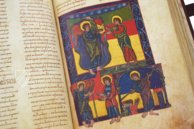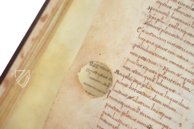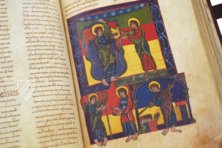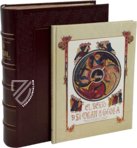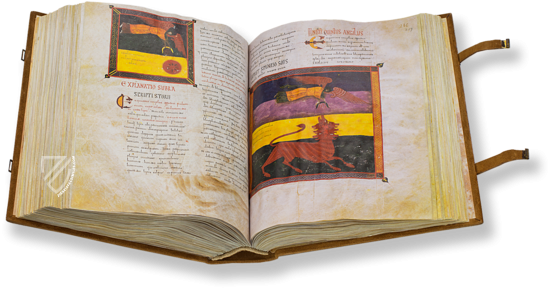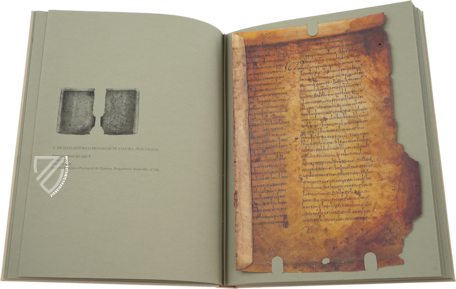Beatus of Liébana - San Millán Codex
(3,000€ - 7,000€)
Saint Beatus of Liébana (c. 730 – c. 800) wrote an authoritative commentary on the Book of Revelation, which was divided into 12 books and originates from ca. 776. It is one of the most influential texts of medieval theology, and inspired the creation of dozens of precious manuscripts, most from Northern Spain. The San Millán Codex represents one of the most complete surviving copies of the famous commentary. It is adorned with 49 full-page miniatures, which were produced in two phases during the 10th and 11th centuries and are fine specimens of the Mozarabic and Romanesque styles. The manuscript is named after the Monastery of San Millán de la Cogolla in La Rioja, where it was completed.
Beatus of Liébana - San Millán Codex
This is a fascinating specimen from the grand tradition of so-called Beatus manuscripts. Saint Beatus of Liébana (c. 730 – c. 800) wrote an authoritative commentary on the Book of Revelation, which was divided into 12 books. It originates from a time when most of the Iberian Peninsula had been overrun by the Moors. Only the Kingdom of Asturias, protected by the Cantabrian Mountains, stood against the Muslim invasion. It was in this precarious situation that Beatus wrote his commentary, and in which its meaning changed. The beast, once representing the Roman Empire, was now replaced by the Muslim Caliphate, and Babylon was no longer Rome, but Córdoba instead. That being said, most of his commentary is actually critical of other Christians, who put their own interests before the will of God, and Muslims are only mentioned in passing. The San Millán Codex also includes the prologue of the Apocalypse that was written by Saint Jerome (347–420), his commentary on the Book of Daniel, and extracts of the Etymologiae by Saint Isidore of Seville (ca. 560–636). 49 full-page miniatures adorn the extensive text, which comprises more than 560 pages. This manuscript represents one of the most complete surviving copies of the famous commentary.
Who Was Beatus?
Beatus of Liébana was a monk, theologian, and member of the Monastery of Santo Toribio de Liébana in Spain. The monk is famous above all for his magnum opus, a commentary on the biblical Apocalypse in twelve books. It originates from ca. 776 and are known today as the Beatus-Series. These twelve books were adapted into countless manuscripts, many of which survive to this day. They are regarded as some of the finest examples of Mozarabic illumination, and were influenced by Moorish art, despite the antagonistic relationship between the two peoples. The majority of Beatus manuscripts originate from between the 10th and 11th centuries in northern Spain. The San Millán Codex was produced during the heyday of Beatus manuscript production.
Mozarabic Art meets the Romanesque
The manuscript at hand was produced in two phases, the first originated at the end of the 10th century in the province of León, and contains the majority of the text and most of the miniatures. These are rendered in the Mozarabic style. The second part originated from the Monastery of San Millán de la Cogolla in La Rioja, after which it is named, probably at the end of the 11th century. One new miniature was added, the preexisting miniatures received additional color, and this second phase shows influences of the Romanesque style. Thus, the manuscript is of great interest to theologians and art historians alike.
Codicology
- Alternative Titles
- Beatus von Liébana - Codex San Millán
San Millan Beatus
Beato de San Millán de la Cogolla
Beato de San Millán
Beatus of Liébana - San Millán Codex - Size / Format
- 564 pages / 35.5 × 24.0 cm
- Origin
- Spain
- Date
- First part: Late 10th or early 11th century (Mozarabic); Second part: second half of the 11th century (Romanesque)
- Style
- Genre
- Language
- Script
- Visigothic
- Illustrations
- 49 large and full-page miniatures
- Content
- Commentary on the Book of Revelation by Beatus of Liébana
- Artist / School
- Beatus of Liébana (died after 798) (author)
Mozarabic and Carolingian influences
Beatus of Liébana - San Millán Codex
John Receives the Revelation of Jesus Christ
An angel hands a book to John of Patmos; both figures have halos, wear robes with a stylized fall of folds, especially John’s swirling black cloak, and stare at each other with large almond-shaped eyes. “The Revelation of Jesus Christ, which God gave Him to show His servants—things which must shortly take place. And He sent and signified it by His angel to His servant John, who bore witness to the word of God, and to the testimony of Jesus Christ, to all things that he saw.” (Rev. 1:1-2)

Beatus of Liébana - San Millán Codex
Vision of the Lamb Receiving the Book with Seven Seals
A kaleidoscope of yellows, reds, blues, black, and white: this roundel is a tetramorph of the four Evangelist Symbols encircling the Lamb of God, which holds the book out toward the beholder. Their wings extend well beyond the borders of their respective medallions in a dynamic, counterclockwise motion that contrasts with the yellow background. The 24 elders, some with hands outstretched in praise, surround the roundel.
This miniature is exemplary of Mozarabic art, which is characterized by bold shapes, opaque primary colors, heavy patterns, and flat, stylized figures without shading. Their two-tone garments consist of simple shapes and folds drawn with black or white lines. Finally, an unfinished manicule in the right margin points to the roundel.

#1 Beato de San Millán
Language: Spanish
(3,000€ - 7,000€)
#2 El Beato de San Millán de la Cogolla
Language: Spanish
(3,000€ - 7,000€)
- Treatises / Secular Books
- Apocalypses / Beatus
- Astronomy / Astrology
- Bestiaries
- Bibles / Gospels
- Chronicles / History / Law
- Geography / Maps
- Saints' Lives
- Islam / Oriental
- Judaism / Hebrew
- Single Leaf Collections
- Leonardo da Vinci
- Literature / Poetry
- Liturgical Manuscripts
- Medicine / Botany / Alchemy
- Music
- Mythology / Prophecies
- Psalters
- Other Religious Books
- Games / Hunting
- Private Devotion Books
- Other Genres
- Afghanistan
- Armenia
- Austria
- Belgium
- Belize
- Bosnia and Herzegovina
- China
- Colombia
- Costa Rica
- Croatia
- Cyprus
- Czech Republic
- Denmark
- Egypt
- El Salvador
- Ethiopia
- France
- Germany
- Greece
- Guatemala
- Honduras
- Hungary
- India
- Iran
- Iraq
- Israel
- Italy
- Japan
- Jordan
- Kazakhstan
- Kyrgyzstan
- Lebanon
- Liechtenstein
- Luxembourg
- Mexico
- Morocco
- Netherlands
- Palestine
- Panama
- Peru
- Poland
- Portugal
- Romania
- Russia
- Serbia
- Spain
- Sri Lanka
- Sweden
- Switzerland
- Syria
- Tajikistan
- Turkey
- Turkmenistan
- Ukraine
- United Kingdom
- United States
- Uzbekistan
- Vatican City
- A. Oosthoek, van Holkema & Warendorf
- Aboca Museum
- Ajuntament de Valencia
- Akademie Verlag
- Akademische Druck- u. Verlagsanstalt (ADEVA)
- Aldo Ausilio Editore - Bottega d’Erasmo
- Alecto Historical Editions
- Alkuin Verlag
- Almqvist & Wiksell
- Amilcare Pizzi
- Andreas & Andreas Verlagsbuchhandlung
- Archa 90
- Archiv Verlag
- Archivi Edizioni
- Arnold Verlag
- ARS
- Ars Magna
- ArtCodex
- AyN Ediciones
- Azimuth Editions
- Badenia Verlag
- Bärenreiter-Verlag
- Belser Verlag
- Belser Verlag / WK Wertkontor
- Benziger Verlag
- Bernardinum Wydawnictwo
- BiblioGemma
- Biblioteca Apostolica Vaticana (Vaticanstadt, Vaticanstadt)
- Bibliotheca Palatina Faksimile Verlag
- Bibliotheca Rara
- Boydell & Brewer
- Bramante Edizioni
- Bredius Genootschap
- Brepols Publishers
- British Library
- C. Weckesser
- Caixa Catalunya
- Canesi
- CAPSA, Ars Scriptoria
- Caratzas Brothers, Publishers
- Carus Verlag
- Casamassima Libri
- Centrum Cartographie Verlag GmbH
- Chavane Verlag
- Christian Brandstätter Verlag
- Circulo Cientifico
- Club Bibliófilo Versol
- Club du Livre
- CM Editores
- Collegium Graphicum
- Collezione Apocrifa Da Vinci
- Comissão Nacional para as Comemorações dos Descobrimentos Portugueses
- Coron Verlag
- Corvina
- CTHS
- D. S. Brewer
- Damon
- De Agostini/UTET
- De Nederlandsche Boekhandel
- De Schutter
- Deuschle & Stemmle
- Deutscher Verlag für Kunstwissenschaft
- DIAMM
- Droz
- E. Schreiber Graphische Kunstanstalten
- Ediciones Boreal
- Ediciones Grial
- Ediclube
- Edições Inapa
- Edilan
- Editalia
- Edition Deuschle
- Edition Georg Popp
- Edition Leipzig
- Edition Libri Illustri
- Editiones Reales Sitios S. L.
- Éditions de l'Oiseau Lyre
- Editions Medicina Rara
- Editorial Casariego
- Editorial Mintzoa
- Editrice Antenore
- Editrice Velar
- Edizioni Edison
- Egeria, S.L.
- Eikon Editores
- Electa
- Emery Walker Limited
- Enciclopèdia Catalana
- Eos-Verlag
- Ephesus Publishing
- Ernst Battenberg
- Eugrammia Press
- Extraordinary Editions
- Fackelverlag
- Facsimila Art & Edition
- Facsimile Editions Ltd.
- Facsimilia Art & Edition Ebert KG
- Faksimile Verlag
- Feuermann Verlag
- Folger Shakespeare Library
- Franco Cosimo Panini Editore
- Friedrich Wittig Verlag
- Fundación Hullera Vasco-Leonesa
- G. Braziller
- Gabriele Mazzotta Editore
- Gebr. Mann Verlag
- Gesellschaft für graphische Industrie
- Getty Research Institute
- Giovanni Domenico de Rossi
- Giunti Editore
- Graffiti
- Grafica European Center of Fine Arts
- Guido Pressler
- Guillermo Blazquez
- Gustav Kiepenheuer
- H. N. Abrams
- Harrassowitz
- Harvard University Press
- Helikon
- Hendrickson Publishers
- Henning Oppermann
- Herder Verlag
- Hes & De Graaf Publishers
- Hoepli
- Holbein-Verlag
- Houghton Library
- Hugo Schmidt Verlag
- Idion Verlag
- Il Bulino, edizioni d'arte
- ILte
- Imago
- Insel Verlag
- Insel-Verlag Anton Kippenberger
- Instituto de Estudios Altoaragoneses
- Instituto Nacional de Antropología e Historia
- Introligatornia Budnik Jerzy
- Istituto dell'Enciclopedia Italiana - Treccani
- Istituto Ellenico di Studi Bizantini e Postbizantini
- Istituto Geografico De Agostini
- Istituto Poligrafico e Zecca dello Stato
- Italarte Art Establishments
- Jan Thorbecke Verlag
- Johnson Reprint Corporation
- Josef Stocker
- Josef Stocker-Schmid
- Jugoslavija
- Karl W. Hiersemann
- Kasper Straube
- Kaydeda Ediciones
- Kindler Verlag / Coron Verlag
- Kodansha International Ltd.
- Konrad Kölbl Verlag
- Kurt Wolff Verlag
- La Liberia dello Stato
- La Linea Editrice
- La Meta Editore
- Lambert Schneider
- Landeskreditbank Baden-Württemberg
- Leo S. Olschki
- Les Incunables
- Liber Artis
- Library of Congress
- Libreria Musicale Italiana
- Lichtdruck
- Lito Immagine Editore
- Lumen Artis
- Lund Humphries
- M. Moleiro Editor
- Maison des Sciences de l'homme et de la société de Poitiers
- Manuscriptum
- Martinus Nijhoff
- Maruzen-Yushodo Co. Ltd.
- MASA
- Massada Publishers
- McGraw-Hill
- Metropolitan Museum of Art
- Militos
- Millennium Liber
- Müller & Schindler
- Nahar - Stavit
- Nahar and Steimatzky
- National Library of Wales
- Neri Pozza
- Nova Charta
- Oceanum Verlag
- Odeon
- Orbis Mediaevalis
- Orbis Pictus
- Österreichische Staatsdruckerei
- Oxford University Press
- Pageant Books
- Parzellers Buchverlag
- Patrimonio Ediciones
- Pattloch Verlag
- PIAF
- Pieper Verlag
- Plon-Nourrit et cie
- Poligrafiche Bolis
- Presses Universitaires de Strasbourg
- Prestel Verlag
- Princeton University Press
- Prisma Verlag
- Priuli & Verlucca, editori
- Pro Sport Verlag
- Propyläen Verlag
- Pytheas Books
- Quaternio Verlag Luzern
- Reales Sitios
- Recht-Verlag
- Reichert Verlag
- Reichsdruckerei
- Reprint Verlag
- Riehn & Reusch
- Roberto Vattori Editore
- Rosenkilde and Bagger
- Roxburghe Club
- Salerno Editrice
- Saltellus Press
- Sandoz
- Sarajevo Svjetlost
- Schöck ArtPrint Kft.
- Schulsinger Brothers
- Scolar Press
- Scrinium
- Scripta Maneant
- Scriptorium
- Shazar
- Siloé, arte y bibliofilia
- SISMEL - Edizioni del Galluzzo
- Sociedad Mexicana de Antropología
- Société des Bibliophiles & Iconophiles de Belgique
- Soncin Publishing
- Sorli Ediciones
- Stainer and Bell
- Studer
- Styria Verlag
- Sumptibus Pragopress
- Szegedi Tudomànyegyetem
- Taberna Libraria
- Tarshish Books
- Taschen
- Tempus Libri
- Testimonio Compañía Editorial
- Thames and Hudson
- The Clear Vue Publishing Partnership Limited
- The Facsimile Codex
- The Folio Society
- The Marquess of Normanby
- The Richard III and Yorkist History Trust
- Tip.Le.Co
- TouchArt
- TREC Publishing House
- TRI Publishing Co.
- Trident Editore
- Tuliba Collection
- Typis Regiae Officinae Polygraphicae
- Union Verlag Berlin
- Universidad de Granada
- University of California Press
- University of Chicago Press
- Urs Graf
- Vallecchi
- Van Wijnen
- VCH, Acta Humaniora
- VDI Verlag
- VEB Deutscher Verlag für Musik
- Verlag Anton Pustet / Andreas Verlag
- Verlag Bibliophile Drucke Josef Stocker
- Verlag der Münchner Drucke
- Verlag für Regionalgeschichte
- Verlag Styria
- Vicent Garcia Editores
- W. Turnowski Ltd.
- W. Turnowsky
- Waanders Printers
- Wiener Mechitharisten-Congregation (Wien, Österreich)
- Wissenschaftliche Buchgesellschaft
- Wissenschaftliche Verlagsgesellschaft
- Wydawnictwo Dolnoslaskie
- Xuntanza Editorial
- Zakład Narodowy
- Zollikofer AG


















